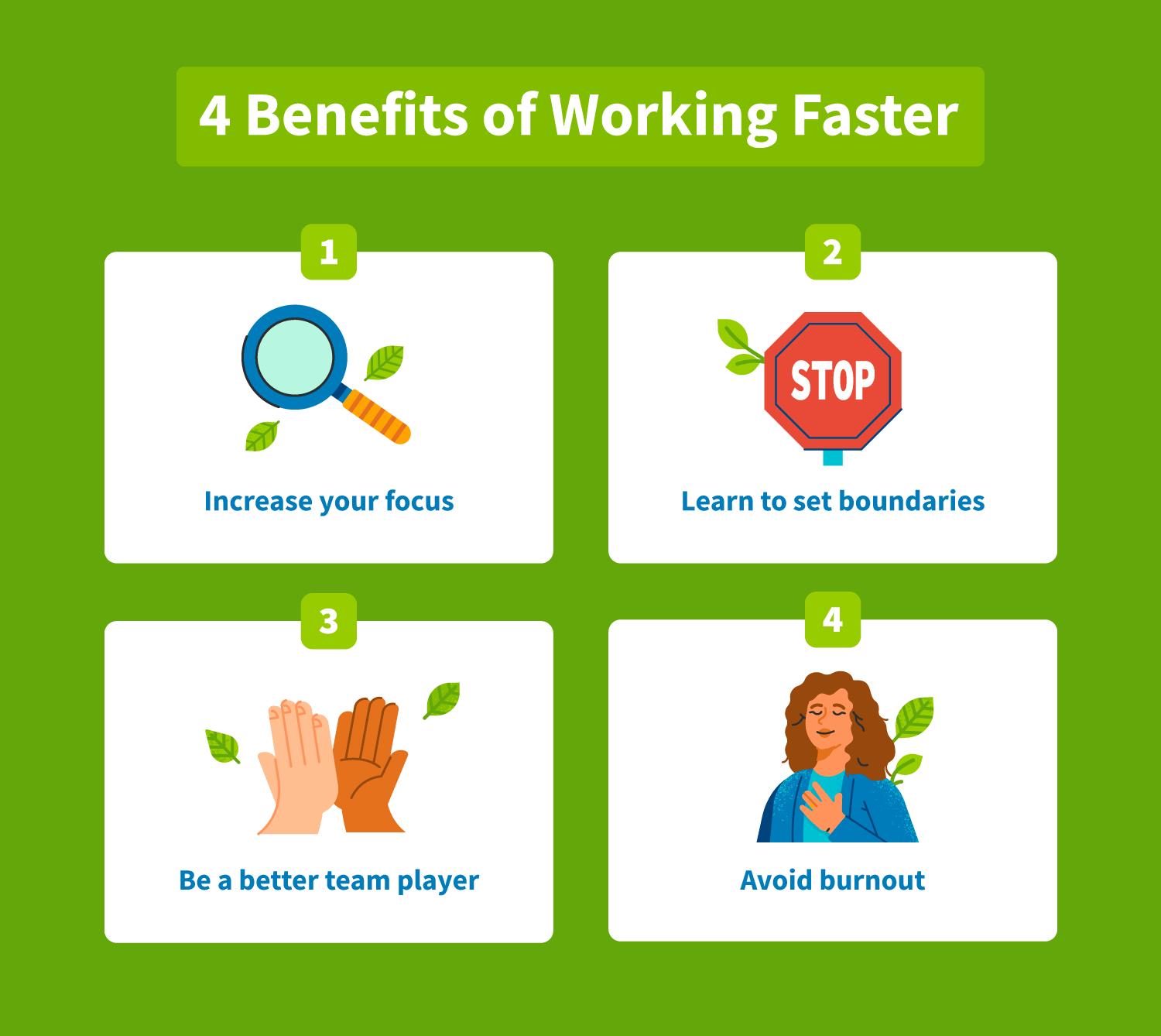
Disclosure regarding our editorial content standards
If you’ve ever been up against a tight deadline, you’ve probably wished you could complete your work faster. But what’s the fastest way to work without losing quality? Each person has different working styles, so we’ve outlined the fastest ways to work based on your specific needs.
In this post, you’ll learn 12 of the best strategies for working faster that are proven through research and used by some of the most successful people on Earth. Whether you work at a company or are self-employed, these methods will help you push ahead of the competition.
Why is it important to work faster and more efficiently?
Learning how to get work done faster can help enhance your career trajectory within an organization. Management teams are looking for employees who not only produce quality work but are also able to do it quickly. This showcases your time management skills, and it can also indicate that you’re able to take on more responsibilities and complex tasks.
When you discover the fastest way to work, it can also help you develop a better work-life balance. How many times have you had to stay late at the office or been at home worried about tasks that are carried over to the next day? These strategies will help you free up additional time and truly be able to relax when you’re off the clock.
The 6 key work styles
Before learning how to work faster, it’s helpful to know your specific work style. Similar to how everyone learns differently, we also have different styles of working. Below, we’ve given a brief overview of the six main work styles:
- Independent: a self-starter who is hardworking and works better solo
- Cooperative: an individual who works better in groups and is great at communicating with others
- Proximity: adapts to different situations with ease and has a wide range of skills
- Supportive: an emotionally intelligent person who supports the group by taking various perspectives and can facilitate collaboration
- Detail-oriented: someone who doesn’t overlook the small stuff and is strategic while also skilled at risk management
- Idea-oriented: a person who is creative, full of ideas, and great at inspiring others with their optimistic outlook
And if you’re not sure which work style aligns with you, check out the flowchart at the end of this article to uncover your specific style.
How to work faster: 12 strategies to work faster (without sacrificing quality)
When you want to learn how to work faster, it’s beneficial to know that there are numerous methods that have actually been proven through research.
1. Practice deep work
Best for: Independent work style
How it helps you work faster: You’ll develop a heightened sense of focus.
As an associate professor at Georgetown, Cal Newport has many responsibilities outside of educating his students. He also has to produce a lot of papers with research findings as well as innovative ideas. When he realized that he wasn’t working to his full potential, he started researching what he now calls “deep work.”
Deep work is defined as “activities performed in a state of distraction-free concentration that push your cognitive capabilities to their limits.” This involves eliminating distractions as much as possible, such as working in isolation, turning off electronics and even disconnecting from the internet.
While some of the limits to your tech use may seem a bit extreme, you’ll benefit from deep work even if you only implement a few of the tips.

2. Incorporate the P.A.R.A. method
Best for: Detail-oriented work style
How it helps you work faster: You’ll be organized and more efficient.
Getting organized is one great way to start working faster. Tiago Forte developed the P.A.R.A. method, which he writes about in his book “Building a Second Brain.”
P.A.R.A. stands for:
P – Projects
A – Areas
R – Resources
A – Archive
Depending on your work, you can begin with any of these pillars. You could start with Areas by organizing the main categories of your work. Then, you can list out the various Projects and deadlines you have for each of the Areas. With Resources, you’ll gather all of your notes for your Projects, which assists with saving time on finding what you need while you work. Finally, be sure to Archive anything that’s completed.
By incorporating the P.A.R.A. method, you’ll eliminate time wasted on figuring out the next step or finding what you need to get the job done.
3. Develop better habits
Best for: Detail-oriented work style
How it helps you work faster: For each good habit you develop, you’ll eliminate a bad habit.
Recently, there’s been a boom in using habits to work faster. Books such as The Power of Habit by Charles Duhigg and Atomic Habits by James Clear have become international bestsellers by teaching people about forming good habits. Forming habits taps into our evolutionary psychology as well as the research from the father of behaviorism, B.F. Skinner.
There are many tips and tricks to forming good habits, and one is to have a routine. If you sit down at work every day and waste 10 minutes mindlessly browsing the internet, it’s time for a change. Make it a goal to reply to five emails or to check your calendar for the day when you first walk in. A small change of habit can have big effects on the rest of your day.

4. Get into flow
Best for: Proximity work style
How it helps you work faster: Your mind will stop wandering as you reach your state of flow.
One of the most notable researchers in the realm of reaching human potential is Mihaly Csikszentmihalyi, who popularized the psychological concept of “flow.” Csikszentmihalyi said that the trick to reaching the flow state is to be fully immersed in a project while also challenging yourself. So, this means you need to both eliminate distractions and make sure the task is moderately difficult.
Flow is also known as “getting in the zone,” which is a common phrase used to discuss top athletes and other professionals who are focused and driven. Reaching the flow state helps you find the quickest way to work while also tapping into your creativity and potential.
This is perfect for a task where you have some competency, but it’s also somewhat new. And if it’s something you’re pretty familiar with, do something to make it slightly more difficult, like giving yourself a time limit or goal to go along with it.
5. Download apps to eliminate distraction
Best for: Proximity work style
How it helps you work faster: You can protect yourself from yourself by limiting access to social media and websites when you should be working.
Oh, so you thought Cal Newport’s only trick was deep work? Think again. In 2019, he wrote a book called Digital Minimalism that’s focused on strategies to avoid digital distractions. In this book, he discusses various apps, like the Freedom app, for smartphones and computers that restrict you from apps and websites.
How often do you go to check Twitter, Instagram or Facebook “real quick” and all of a sudden, you lose 30 minutes from scrolling? Apps like Freedom allow you to block these distractions during certain times of day so you can sit down and focus on your work.

6. Block your calendar
Best for: Supportive work style
How it helps you work faster: You’ll eliminate wasted time and always have something to work on.
This strategy involves accounting for every hour of the day down to the minute, and while this may seem a little overkill, it’s extremely beneficial. Yes, you’ll be blocking out time on your calendar for tasks and strategy sessions, but you’ll also be scheduling time for breaks. Calendar blocking is a technique that’s perfect for the digital age, but you can also utilize this strategy if you still use a physical planner.
With this strategy, you can easily set a specific time of day where you do a specific task. Lastly, think of blank spaces on your calendar as additional time just in case something unexpected happens while working on a task such as an unscheduled meeting or call. By doing this, you’ll never miss a beat as every hour and minute of your day is accounted for.
7. Learn to say “no”
Best for: Supportive work style
How it helps you work faster: You won’t get pulled away from your work nearly as much.
Some of us are people pleasers and say “yes” to any request that comes our way. As you continue to agree to help everyone else, you’re losing time for your own work. Being helpful is a great quality, but when you don’t balance it with boundaries, you’ll never get your work done, faster or not.
Knowing how to be efficient means knowing how to say “no.” To soften the blow, be honest. People respect when you let them know that you’re busy. And you can always let your colleague know that you might be able to help after you complete some pressing tasks on your to-do list.

8. Try the five-minute rule
Best for: Cooperative work style
How it helps you work faster: You’ll get the small things done while helping others continue to progress in their work as well.
The five-minute rule is a fantastic strategy that comes from the book Getting Things Done by David Allen. It’s a simple strategy that’s great for getting small tasks off of your plate. Basically, if the task takes five minutes or less, just do it.
Many people let emails or small tasks pile up because they feel like they can “just do it later.” This puts you at risk of forgetting or holding others back from completing their next task. When you use the five-minute rule, it knocks small to-do’s off of your list and helps you feel more accomplished as you move to bigger tasks.
9. Reorganize the “boring” tasks
Best for: Cooperative work style
How it helps you work faster: You won’t procrastinate as much because you’ll enjoy what you’re doing.
We’re all different. Some of us love data and numbers, and some of us love being creative or writing. In collaborative settings, we don’t often take advantage of the fact that we all enjoy doing different tasks. What’s boring to one person may be fun and interesting to another, so it’s all about your personal preferences.
If you want to know how to get the job done faster, be intentional about recruiting a team to help. With a dedicated team, you can talk with them and reorganize these types of tasks. If you’re doing something you enjoy, you can hit that state of flow and get more work done than being bored with what you’re doing.

10. Outsource what you can
Best for: Idea-oriented work style
How it helps you work faster: You can utilize your strengths while eliminating small tasks.
You have strengths and areas where you shine, so it doesn’t make sense to spend your time on something trivial that someone else could be doing. If there are low-stakes tasks that you can take off your plate, do it. Maybe it’s data entry, filling out forms or organizing paperwork. These are the tasks a colleague can do that will free up some of your time for other to-do’s.
Depending on your situation, there are different options. If your company has interns, these tasks may be something you can hand off to them. If you or your company has the budget, maybe you can hire a freelancer or assistant.
Even if this costs a little money, it might be worth it because you’ll be able to complete projects that drive larger profits. And don’t forget, increasing profits is always a fantastic achievement to showcase when asking for a raise.
If you’re a student working on a group project, this can be a great strategy for you, too. Ask yourself, “What tasks can we get outside help with?”
11. Stop multitasking
Best for: Idea-oriented work style
How it helps you work faster: You’ll stop losing the time it takes to switch your attention between tasks.
Hopefully, we’ve debunked some popular myths for you by now, but we have one more big one. One major myth that you may believe is that multitasking makes you more productive. The reality is that it’s making you less productive and costing you time. A Yale School of Management article explains how productivity from multitasking is an illusion.
Your brain is incredible, but it has its limitations. While you may believe you’re multitasking, you’re actually switching your attention, and it takes additional time to get back to the previous task. So, although you may pride yourself as a multitasker, it’s better to focus on one thing at a time.

12. Take regular breaks
Best for: All work styles
How it helps you work faster: You’ll avoid burnout and will be more productive.
One of the biggest misconceptions for learning how to do things faster is the belief that you should eliminate breaks. This couldn’t be further from the truth. According to researchers at the University of North Carolina at Chapel Hill, taking breaks makes you more productive.
One study from Occupational Medicine shows millennials are facing higher burnout rates than other generations, and it’s because they think they need to work 24/7. Taking breaks gives you an opportunity to get creative, reflect on challenges you’re facing with a project and, most importantly, rejuvenate.
Finding your optimal work style
You have the strategies, but you might be struggling with knowing what your specific work style is. Knowing your work style will help you work faster and more efficiently, and it can also help you with managing your teams and collaborating.
When you understand individual work styles, your work becomes like a well-oiled machine. Below, we’ve put together a flowchart to help you figure out yours.



Focus on your future
Now that you have the strategies in place to work faster while maintaining quality, you’re going to notice that it frees up some valuable time. Along with working faster comes more financial prosperity.
With these benefits, it’s time to think about your future and use this time to start focusing on repairing and improving your credit score. When you improve your credit score, a world of opportunities opens up. To learn how we can help, contact our advisors today for additional information.
Note: The information provided on CreditRepair.com does not, and is not intended to, act as legal, financial or credit advice; instead, it is for general informational purposes only.
Questions about credit repair?
Chat with an expert: 1-800-255-0263






